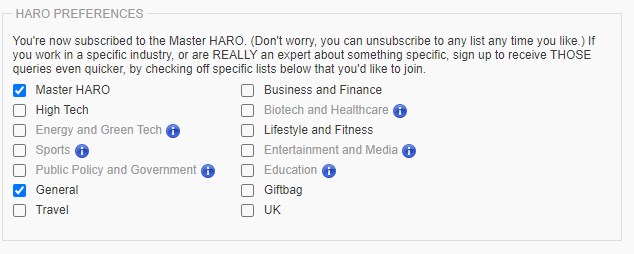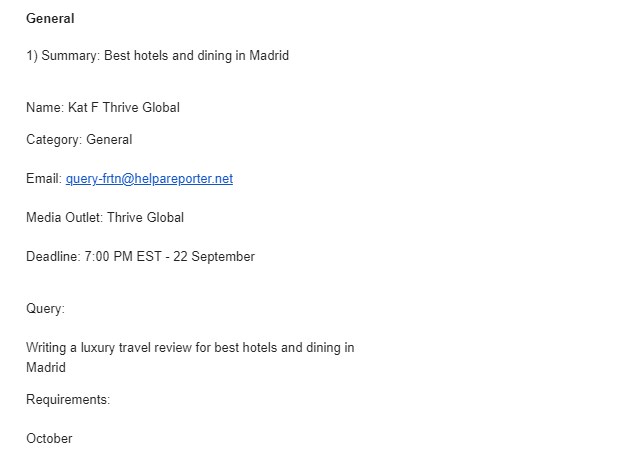Links from media publications can be a game-changer for your website’s authority and visibility. HARO lets you earn high-quality backlinks from authoritative websites like the New York Times and Mashable.
However, although winning these backlinks is free, it requires some research and communication skills. In this article, we’ll tell you how to respond to a HARO query and get a positive response.
Let’s get started.
How to Respond to a HARO Query: Ultimate Guide
Understanding HARO
According to Entrepreneur, HARO receives 50,000 queries every month. HARO stands for Help A Reporter Out. The service bridges subject matter experts to journalists or media publications. As the name suggests, HARO helps reporters get expert opinions on particular topics for their audience.
The platform creates a win-win situation, helping reporters find great content and offering website owners valuable media coverage and backlinks. HARO has an extensive, ever-updating database of queries in virtually every industry.
How to Get Started with HARO in 3 Steps
Sign Up
Start by going to the HARO website and sign up as a publisher if you haven’t already.

While signing up, make sure to enter your correct name, address, country, and company. You’ll get a confirmation link in your email inbox as soon as you submit your basic information.
Set Up Your Profile
Once you’re signed up, it’s time to set your HARO preferences. This is an important part.

The boxes you tick on this page determine what kind of queries you’ll be receiving in your inbox. Only tick-mark relevant categories to receive queries that matter to your business. Also, unfortunately, there’s a limited number of categories you can sign up for.
Start Responding to Queries
The third step is to respond to the right queries, in the right way, at the right time. Let’s see how you can do that.
How to Respond to a HARO Query
What’s a HARO Query?
In short, a HARO query is a request you receive from journalists automatically in your inbox at specific times of the day. A typical HARO query includes information like what the content topic is and who should respond.
Here’s an example from the “General” category:

A HARO query has the following parts:
- The main topic (Summary)
- Category
- An email address
- The media outlet
- The deadline
- The Query (What the journalist needs)
- Requirements (Who they’re looking for)
Now, thousands of content creators sign up for HARO to earn backlinks and coverage from top publications. So, there’s high competition. To get a response from a journalist, you need to be at the top of your game.
Understand the Requirements
As soon as you receive a relevant query in your inbox, read them quickly to understand the requirements.
- Are you the expert they’re looking for?
- Can you add value to the topic?
Identify the Intended Audience
If you want to get the attention of a journalist, you need to make your response extremely helpful and relevant to the topic in question. Craft a response keeping in mind the target audience of the journalist.
Craft a Catchy Subject Line
Write a simple yet catchy subject line with the right keywords or phrases such as:
- The title of the query
- The media outlet
- And your expertise
Prove Your Credibility
You don’t want to make the journalist do the extra work to make sure you’re a credible resource. Include every important piece of information that proves your credibility as the subject matter expert.
This includes:
- Your job title
- The company you work for
- A link to your published work
However, don’t go overboard with the word count; keep your bio less than 50 words.
You May Also Like: How to Choose Between Niche Edits and Guest Posts
Include Data to Support Your Statements
Data adds authenticity to your statements. Add relevant pieces of research to back your opinions. Don’t forget to add links to authentic resources. It’ll allow the journalist to fact-check the information.
Keep It Concise
Keep your HARO pitch concise, skimmable, and easy to read. Add bullet points, use simple language, and keep it between 150 and 300 words.
Stick to the Rules
Don’t forget to go through the rules of the platform before starting your pitching journey.
Related Post: Digital PR and SEO (What’s the Relationships?)
How to Respond to a HARO Query: FAQs
What is a HARO Query?
A HARO query is a request from a journalist or a reporter. It’s sent to interested content creators to get their expertise on a topic of their expertise. Every HARO query has the following parts: Main topic, category, email address, media outlet, deadline, Query, and requirements.
How Do You Write a HARO Response?
A HARO response should be clear, concise, relevant, and highly helpful. It should speak to the audience the reporter is trying to speak to.
How to Be Successful with HARO?
Success with HARO starts with selecting the right categories under “Preferences”. Moreover, respond quickly, address the question directly, include your credentials, use data to support your statements, and speak directly to the target audience.
How Does the HARO Work?
Help A Reporter Out connects journalists or reporters with topic experts. It’s a service that creates a win-win situation for both. Website owners get more visibility, whereas journalists get high-quality, credible content.
What Media Outlets Use HARO?
Well over 70,000 journalists and bloggers use HARO, including top media outlets like Fox News, the Wall Street Journal, Reuters, and the New York Times.
Conclusion: Responding to a HARO Query
Effective HARO link-building can be a game-changer for your site’s visibility and backlink profile. It’s the only free way to get super high-quality backlinks from authoritative media outlets.
HARO queries are emails you get from journalists requesting your input on a specific topic. If they like your response, they use your content, and your website gets featured. Once you get a HARO query, respond promptly, write a catchy subject line, showcase your credibility, and be concise.
Related Posts:




